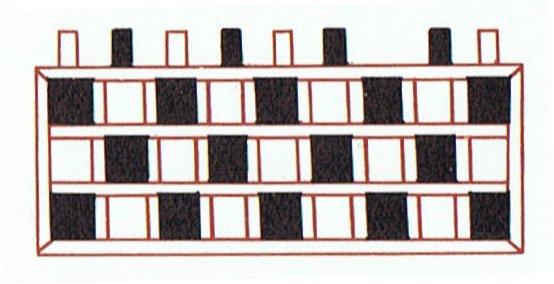|
TRANSLATIONS
Next page:
The flowing outstretched legs in hanau could allude to the waves of the sea. Likewise the semicircular form created by the wing-like arms in tagata could allude to the dome of the sky, the firmament (firma permanent). Neither fingers nor toes are visible in tagata glyphs. I guess it means there is no movement, no flow. Dry and stiff he stands there. Next page:
Wilkinson has also this picture to offer:
The arrangement with the 'dogs' seen at the top (4 white and 4 black and one empty position) he comments because it is the way of the Egyptian 'broken' perspective. The pieces are standing on the chessboard, but the Egyptians show the board as if it was the side of the box. The Dogon people lives within walking distance from Egypt and I remember the granary: "Ogotemmêli, having described the structure as a granary, now proceeded to explain its design. 'The whole thing,' he said, 'with its stairways is called the Granary of the Master of Pure Earth. It is divided into eight compartments, four below and four above. The door opens to the north on the sixth stair. It is as it were the mouth, and the granary is the belly, that is the interior, of the world ..."
"The symbolic significance of this structure was as follows: The circular base represented the sun. The square roof represented the sky. A circle in the center of the roof represented the moon. The tread of each step being female and the rise of each step male, the four stairways of ten steps together prefigured the eight tens of families, offspring of the eight ancestors. Each stairway held one kind of creature, and was associated with a constellation, as follows: The north stairway, associated with the Pleiades, was for men and fishes; the south stairway, associated with Orion's Belt, was for domestic animals. The east stairway, associated with Venus, was for birds. The west stairway, associated with the so-called 'Long-tailed Star', was for wild animals, vegetables, and insects." The broken perspective resembles the steps of the stairways of the granary. The tread is female and the rise is male. From which we can conclude that the 'dogs' are male and the board female. There are 3 * 9 = 27 squares on the Egyptian board, which suggests a cube rather than a flat surface. The cube belongs to Saturn, the creative 7th ancestor. If there is a square in the sky it should be the Pegasus square. 27 is an odd number and there are 5 + 4 + 5 = 14 black squares (representing the water below or the moon). The white (dry earth, sun) squares are 4 + 5 + 4 = 13. Black dominates not only in number but also in being at the corners of the board. Our own chessboard also has a black square at bottom right, tradition rules. The Dogon shrine has a checkerboard on its façade:
It shows only 3 * 8 = 24 squares and a balance between black and white. ... Above the door of the temple is depicted a chequer-board of white squares alternating with squares the colour of the mud wall. There should strictly be eight rows, one for each ancestor. This chequer-board is pre-eminently the symbol of the 'things of this world' and especially of the structure and basic objects of human organization. It symbolizes: the pall which covers the dead, with its eight strips of black and white squares representing the multiplication of the eight of human families; the façade of the large house with its eighty niches, home of the ancestors; the cultivated fields, patterned like the pall; the villages with streets like seams, and more generally all regions inhabited, cleared or exploited by men. The chequer-board and the covering both portray the eight ancestors ... Black is the mud from which new things appear, white is the dry earth on which nothing grows. The checkerboard represents the worked surface of the earth, a mixture of water from below and fire from above. Man's life is played on this board, and it is governed by the gods and they play it with dies. The moves are made through the planets, which then execute the orders from the players above. |





